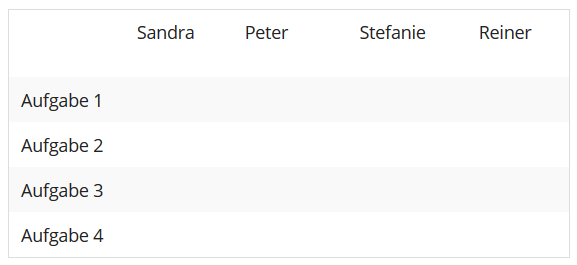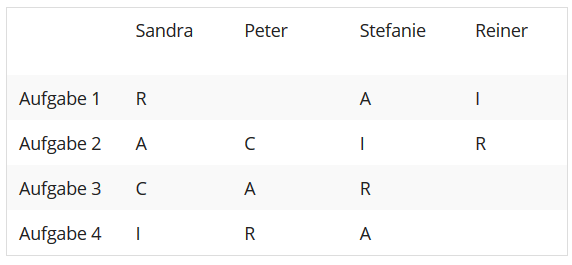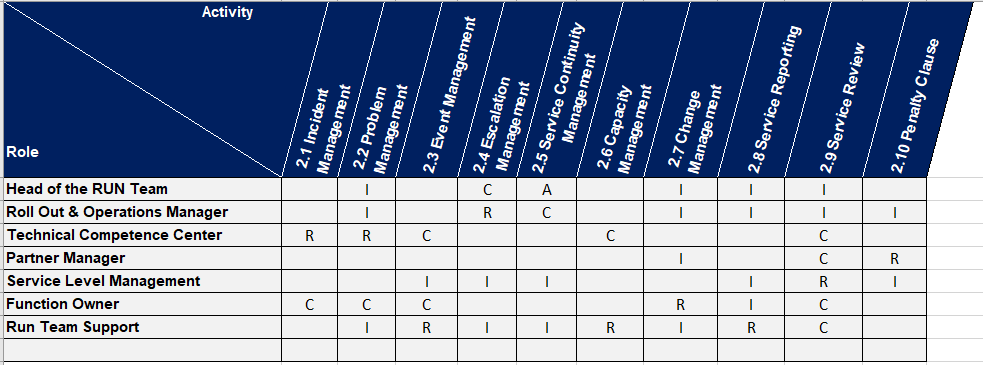RACI Matrix - for a better overview of (project) participants
Everyday project work is usually characterized by a hectic pace, tight deadlines, lots of to-dos and an unmanageable number of participants. It is not always easy to maintain an overview.
Of course, there are also exceptional projects with few participants, a manageable scope and everything goes according to plan and without stress. But how often do you get to enjoy this? In most cases, we have little influence on the scope of the project and cannot really choose who can and/or must contribute to its success. However, there is room for maneuver when it comes to "overview". There are a few methods and tools to improve transparency in the project and shed some light on the darkness. This increases the fun factor in the project.
One method, for example, is the RACI matrix, which we would like to introduce to you in more detail.
Definition RACI Matrix
The RACI or RAM (Responsibility Assignment Matrix) is a matrix that maps the (project) participants and their respective responsibilities (who does what).
However, the abbreviation "RAM" is not advantageous, especially in the IT environment. Most people will associate this term more with random-access memory(RAM). We will therefore leave it at RACI to avoid possible confusion and misleading information.
The acronym RACI stands for Resposible, Accountable, Consulted, Informedand is defined as follows:
R - Responsible: Who is responsible for the implementation?
A - Accountable: Who has overall responsibility (e.g. budget approval)?
C - Consulted: Who supports the implementation in an advisory capacity?
I - Informed: Who is to be informed about the results of the task?
Structure and application
The application of the RACI matrix is quite simple and self-explanatory. The respective participants or roles and the task fields are compared in a matrix and thus form the basic framework (Figure 1).
Note: The division can be made according to personal preference (rows = roles/names, columns = tasks or vice versa).

The responsibilities for the individual tasks are then assigned by entering the corresponding letters(R A C I) in the matrix (Figure 2).

Use in practice
The typical application scenarios for the RACI matrix include the aforementioned listing of project participants and their responsibilities. This can be done in different ways and with different intentions. A popular application is, among other things, the (vacation) substitution, in which the substitution receives an overview of tasks and corresponding communication partners and thus has an overview.
A much more extensive application is found, for example, in service level agreements (SLA). Here, responsibilities are assigned between the respective roles and typical task fields of service level management (according to ITIL). In this way, the responsibilities, roles and information paths between two parties are defined. This increases transparency in what is usually a complex environment.

Essential basic principles
When creating the RACI matrix, a few basic rules should be observed in order to avoid possible misinterpretations and distorted expectations:
- It is not mandatory to fill in the matrix completely (a letter/responsibility does not have to be defined in every field).
- If possible, only one responsible person (R) should be defined for a task, as
-> if there are several (R), the clear responsibility is otherwise lost,
-> if there is no one (R) - no one is responsible for the task,
-> if there are several (R), then the task should be split up or broken down more precisely in order to avoid possible overlaps. - If possible, only one(A) per task, otherwise there is a risk of bottlenecking.
- Commitment from all parties involved helps to rule out possible misunderstandings.
Tips for using the RACI Matrix
- When creating the RACI matrix, it is extremely important to create a common understanding among those involved at the outset, especially in a complex environment:
o Essential basic principles of the RACI matrix should be known.
o From which perspective are we looking at the task area?
o What are the specific tasks behind a task area?
o How are the processes involved in completing the task?
o Which roles are involved in the fulfillment of the task? (clear separation of tasks) - For complex issues, the participation of persons involved is recommended. Alternatively, the RACI matrix created must be subsequently coordinated with the parties involved.
- Practical examples and concrete use cases from the respective sub-area are very helpful in defining the right responsibilities and understanding processes better.
- The definition of RACI (meaning of individual "letters") should always be visible to everyone involved during the creation process and must always be displayed. This is helpful for differentiating between the individual responsibilities, as queries can often arise.
Extension of the RACI matrix
The RACI Matrix is not only simple in its basic form, but can also be individually adapted and expanded. In this way, different variations of the original RACI matrix can be used depending on the intended use.
One possible variation is the RASIC (or RASCI), which includes an extension by S = Support. This refers to persons who support the "responsible" person in carrying out the task(support). It has proven its worth, for example, for mapping the responsibilities of IT systems.
Another variant is the CAIRO matrix, which adds O = Omitted to the standard RACI (different arrangement of letters). This allows specifically assigned persons to be excluded from a task.
There are numerous variations of the standard RACI matrix, which entail additional responsibilities and supplement or replace existing ones. Once the basic principle has been understood, new variations can be used for specific purposes.
Advantages of the RACI Matrix
+ Transparency about the roles and their responsibilities for the respective tasks.
+ Clear allocation of tasks and responsibilities
+ Improvement of communication
+ Eliminate misunderstandings and distorted expectations
+ Very easy to create
+ Completed matrix can be reused or used as a template for similar purposes
+ Can be expanded as required (variations)
+ Versatile in use
Conclusion
The RACI matrix is a method that is relatively easy to learn and use in order to obtain an overview of the tasks and persons/roles/organizational units involved in a specific context. Due to its simple structure and individual adaptability, the RACI matrix can be used for a wide variety of purposes and thus contributes to increasing transparency in the environment in which it is used.
These blog posts may also be of interest:
https://blog.doubleslash.de/ist-improvisationstalent-die-wichtigste-kompetenz-im-projektmanagement/
https://blog.doubleslash.de/scrum-ein-reality-check/
https://blog.doubleslash.de/die-3-top-trends-im-projektmanagement/
https://blog.doubleslash.de/fusball-und-projektmanagement/

